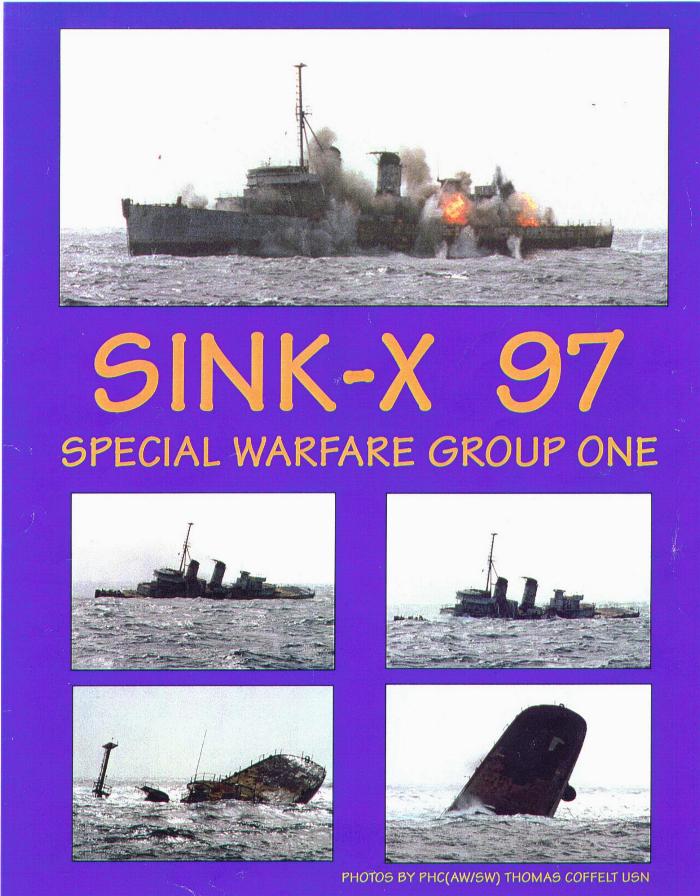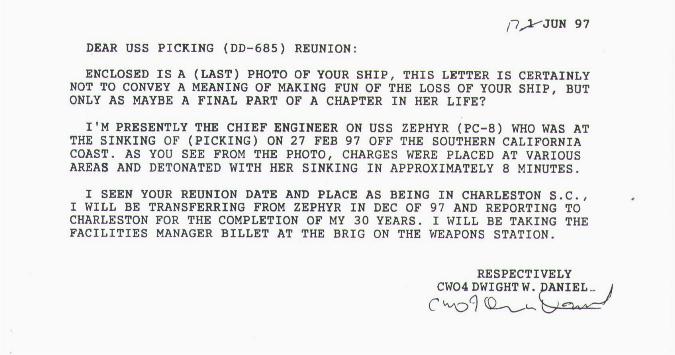History
CLASS - FLETCHER
As Built:
Displacement 2924 Tons (Full), Dimensions, 376' 5"(oa) x 39' 7" x 13'
9" (Max)
Armament 5 x 5"/38AA, 4 x 1.1" AA, 4 x 20mm AA, 10 x 21" tt.(2x5)
Machinery, 60,000 SHP; General Electric Geared Turbines, 2 screws
Speed, 38 Knots, Range 6500 NM@ 15 Knots, Crew 273
Operational and Building Data
Laid down by Bethlehem Steel, Staten Island NY 24 November 1942
Launched June 1 1943 and commissioned 21 September 1943
Decommissioned 20 December 1945, recommissioned 26 January 1951
Decommissioned 4 December 1969
Stricken 1 March 1975
Fate: Designated as a target in June 1976, sunk 27
February 1997
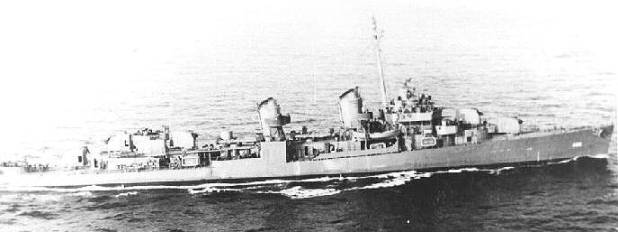
USS Picking (DD-685) Underway 1943
WORLD WAR II (1943-1945)
The USS PICKING had her keel laiid on 24 November 1942, was launched on 15 June
1943 and was commissioned at the Brooklyn Navy Yard on 21 September 1943. at which time Commander
Raymond S. Lamb, USN, assumed command.
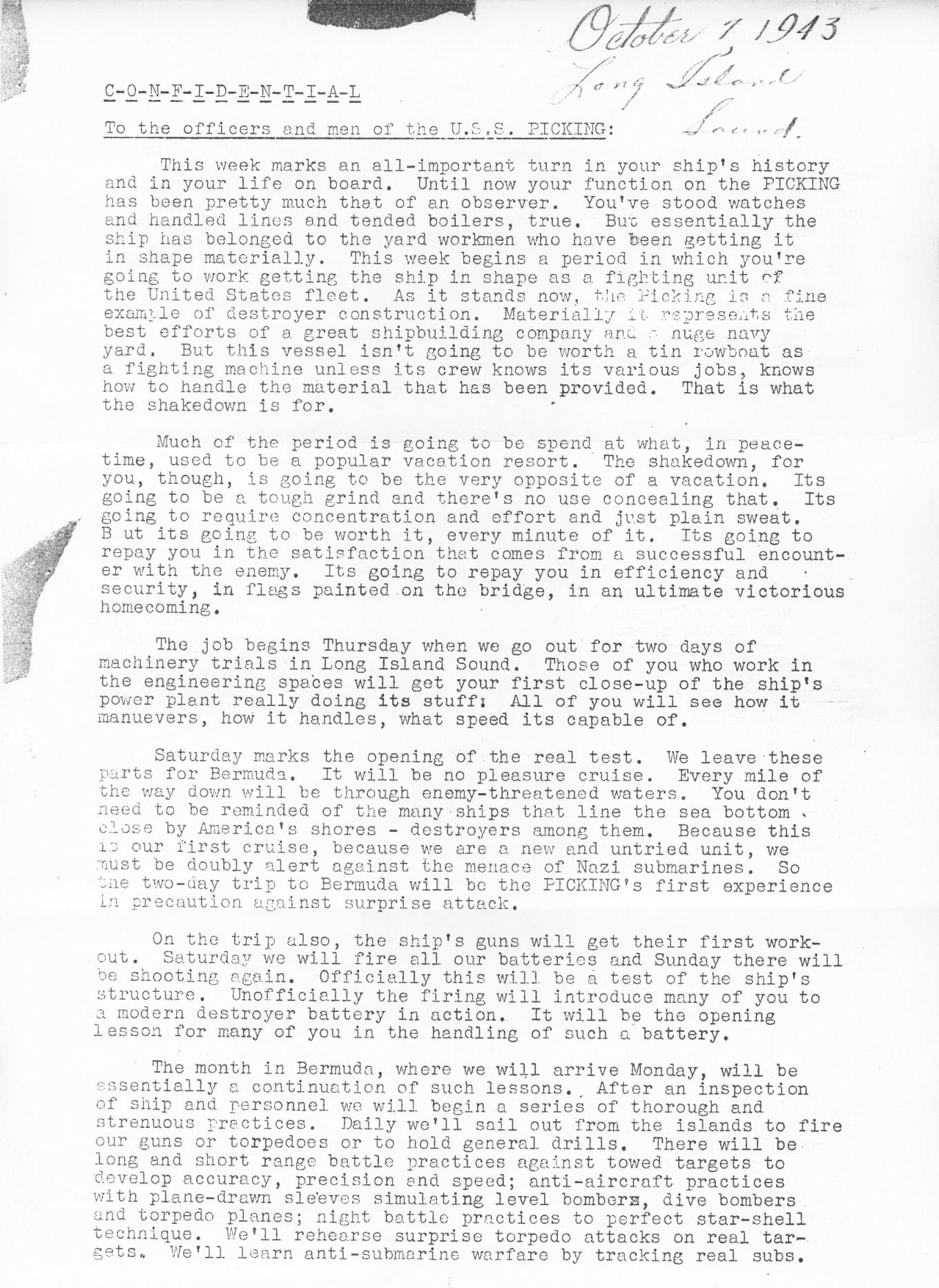
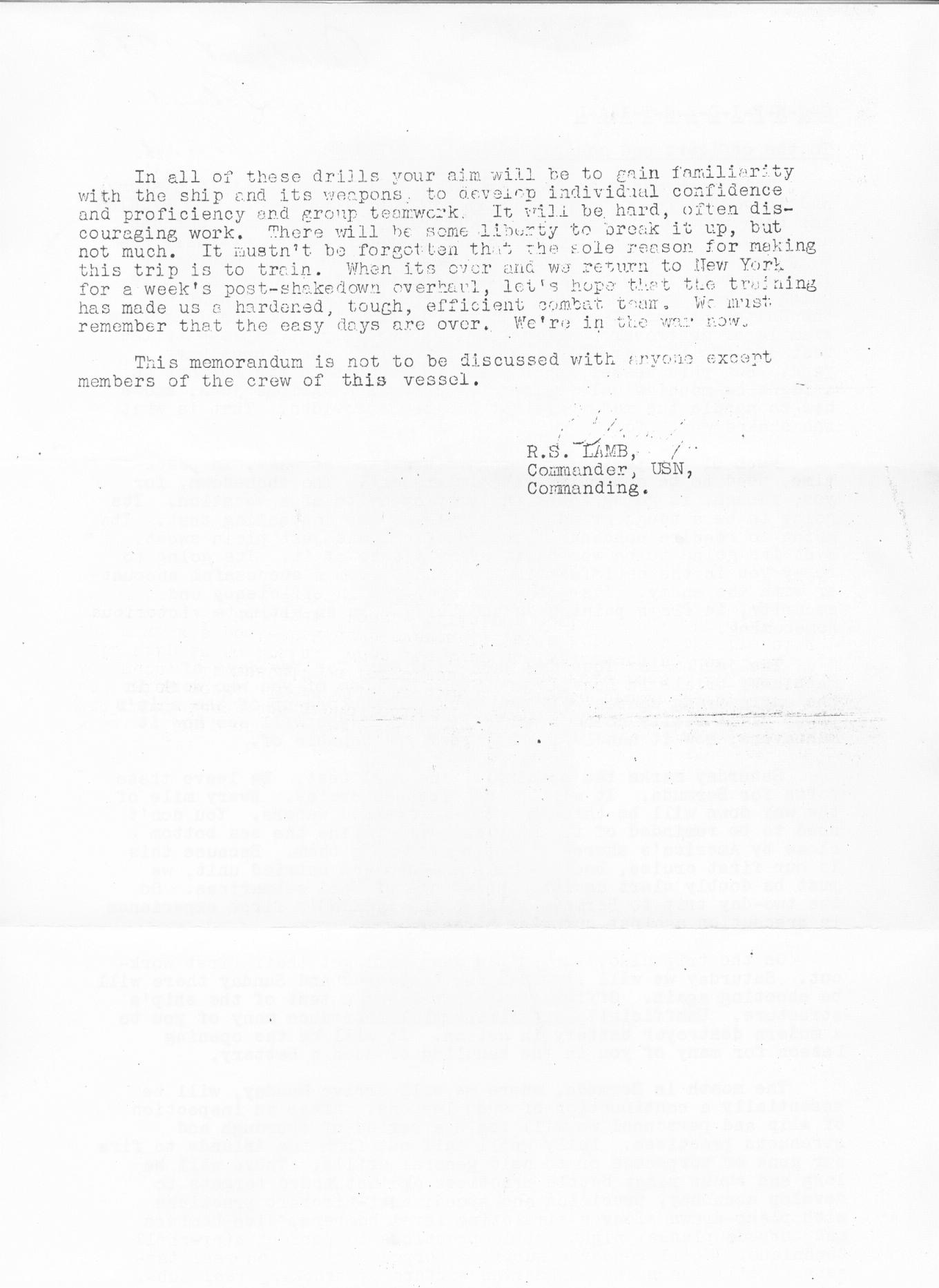
(Courtesy of Doc Bushman!)
After a six week shakedown In the Bermuda area of the British West Indies and a post-shakedown overhaul, the PICKING proceeded to the Canal Zone. Upon arrival at Balboa, C.Z. on December 9th, she reported to the Commander in Chief Pacific Fleet, for duty and shortly thereafter was assigned to the North Pacific Fleet.
The PICKING then sailed for Dutch Harbor in the Aleutian Islands and upon arrival, December 28, 1943, reported to Commander North Pacific Fleet and Commander Destroyer Squadron 49. Captain H. F. Gearing, USN Commer DesRon 49, shifted his pennant aboard the USS PlCKlNG on January 2, 1944.
For the next seven months the PICKING operated with the NINTH Fleet in the Aleutian area and during this time five offensive operations were carried out out enemy shipping and installations In the Jap-held-Kurile Islands.
The first of these attacks occurred on February 4, 1944, when the destroyers and cruisers of the NINTH fleet bombarded the Karabusaki area on Paramushiru. This was the first naval bombardment of Japanese home territory of World War II. Though there was some return fire from enemy batteries, none of the ships were hit and all returned to port unharmed except for damage caused by heavy North Pacific seas.
On the 13th of June, the PICKING with destroyers and cruisers of the NINTH fleet, bombarded Matsuwa. Since dense fog prevented sighting of the island, the approach to the target and subsequent bombardment were carried out entirely by radar.
The 1st of August, the force sailed from Attu, Aleutian Islands, for a third bombardment of Paramushiru. However, during the approach, the task force was twice detected by enemy planes and since surprise was considered essential to the success of the mission, the bombardment was abandoned.
During the intervals between these operations, the PICKING was employed in routine assignments of escort duty, antisubmarine sweeps, searching for pilots of friendly planes forced down at sea, and training exercises; the ship being based at Adak and Attu during the entire period. , A considerable portion of the time in port was spent repairing damage to the ship caused by the foul weather of the Aleutians. It was a testimony to the excellence of Navy material that the ship was able to take the constant weather battering without suffering more damage than she did, for she was never prevented from fully carrying out any of her assignments.
The PICKING left the Aleutian area for San Francisco, California, on August 9,1944, and upon arrival spent a ten-day availability period for up keep.
During this period, Lieutenant Commander B. J. Semmes, Jr., USN, relieved Commander
R. S. Lamb, USN, as Commanding Officer and Captain E. R. McLean, USN, relieved Captain H. F.
Gearing, USN, as Commander, Destroyer Squadron 49.
The PICKING then left the West Coast and sailed for Pearl Harbor, Territory of Hawaii, where she arrived on August 31, 1944, and reported to the Commander, THIRS Fleet, for duty. After a period of training and rehearsal exercises in Hawaiian waters, the destroyer departed for Manus, Admiralty Islands, on September 15th as one of the escort vessels for several divisions of attack transports. The ships reached Seeadler Harbor, Manus, on October 3rd after an uneventful voyage.
For the next six months the PICKING was temporarily assigned to the SEVENTH Fleet and, during this time, participated In the Philippine Campaign Operations.
With destination the Philippine Area, the PICKING left Manus on October 14th as an escort vessel for the Southern Attack Force. The attack force entered Leyte Gulf, Philippine Islands, on the 20th after an uneventful voyage and, during the next four days, the DD685 functioned as part of the antiaircraft and antisubmarine screen for transports and landing craft during the assault on the southern beaches. At sunset on the 20th, three high-flying Japanese "Sally's" were taken under fire by the PICKING'S 5-inch and automatic weapons with unobserved results. Though other planes were seen during the succeeding four days, none of them came within effective gun range.
On the afternoon of October 24, 1944, the PICKING weighed anchor from Leyte Gulf as part of the escort for the unloaded transports which were retiring to Hollandia, New Guinea. That night the force was approached by two unidentified planes which the PICKING took under fire. One of the planes was destroyed and the other retired without attacking.
On the 26th of October, 1944, the PICKING was detached to join the escort of the MOUNT OLYMPUS and AURIG which were leaving Leyte Gulf for Manus. From this date until December 27th, the destroyer was engaged in routine escort duties or tasks in connection with ship's replenishment and maintenance.
The DD 685 escorted transports loaded with reinforcements back Into Leyte Gulf on November 20th and while unloading operations were proceeding, the force was attacked by four "suicide" Japanese fighter planes. Two of these were taken under fire by the ship's batteries and the PICKING was credited with an "assist" in splashing one of these planes. This was the only action of importance which occurred during this period.
During the assault on the beaches at Lingayen Gulf on January 9th, the PICKING functioned as part of the antisubmarine and antiaircraft screen for the transports and landing craft. Several enemy aircraft were taken under fire b the PICKING but no observed damage was done to the enemy planes. On the evening of the 9th the PICKING joined the screen for the unloaded transports and the group retired to Leyte Gulf without incident.
From the 2nd to the 13th of February. the ship operated in and about Subic Bay, Philippine Islands.
On the 13th of February, the PICKING and the USS YOUNG gave close fire support to minesweepers clearing known minefields from the waters around Marivoles Bay and Corregidor. As the enemy did not fire at the minesweeping vessels, the PICKING bombarded targets of opportunity on Southern Corregidor and around the entrance to Mariveles Bay. The PICKING fired the first shell of the war, from a U.S. Navy vessel, into
Corregidor.
On the night of February 14-15. the DD 685 screened assault shipping from Subic Bay to Moriveles Bay. The destroyer then carried out scheduled bombardment of the east side of the Bay, immediately prior to the landings. which were effected without difficulty about 9 o'clock p.m. Throughout the remainder of the day the ship was engaged in screening operations.
The following morning (February 16, 1945), the PICKING carried out a scheduled bombardment and close support of the beachhead in the San Jose area of Corregidor. After the landing of the U.S. troops, targets of opportunity were taken under fire. At least one enemy battery, firing at the landing craft, was silenced by direct hits from the PICKING'S 5 inch guns, and mortar fire from the beaches was also neutralized.
On April 1st, 1945, the PICKING was assigned for duty in Task Force 54, the fire support and covering force for the Okinawa operation. She remained with this force for the next 68 days, operating principally as fire support ship for land operations and occasionally as a screening vessel for the cruisers and battleships of the task force. Also, she sometimes acted as "fly catcher" to prevent Jap small craft activity1 particularly that of suicide boats. During this period of constant day and night bombardment, the PICKING fired over 15,000 rounds of 5-inch ammunition into Japanese positions on southern Okinawa, destroying a number of enemy artillery pieces, dumps, vehicles, pill boxes, sealing numerous caves and killing an unknown number of enemy troops.
The ship was almost constantly on firing station except for those periods when it was necessary to replenish fuel and ammunition or when she was assigned screening duties. During the day, the firing was directed by air and land spotters. At night, illumination and harassing fire was conducted by sector fire and, when necessary, directed by land spotters.
Hardly a day passed without at least one enemy air raid, usually there were several. During daylight most of the enemy planes were intercepted and destroyed before reaching the area of concentrated shipping around southern Okinawa, but at night the Japs were able to reach the area almost at will. While the Jap activities were a nuisance, they did very little effective damage.
On the 3rd of April, shortly after midnight while screening battleships and cruisers of Task Force 54 in their night retirement west of Okinawa, the PICKING was attacked by a low flying "Betty" which dropped a torpedo. After passing close astern of the destroyer, the "tin fish" exploded harmlessly.
The PlCKING was fired on by a shore battery, April 5th, which was located on southern Okinawa. The principal target for the enemy battery, however, proved to be the USS NEVADA which was hit several times. Together with the other fire support ships, the PICKING conducted counter battery fire which speedily eliminated the enemy gun position.
The following afternoon, while proceeding to loin the heavy units of Task Force 54 for the night retirement sortie, the PICKING was attacked by four "Tony" type Japanese planes approaching low over the water. Two of these were driven off by gunfire but the other two persisted in their attack. The first of these exploded from 40 millimeter hits and crashed into the water 200 yards off the port quarter. Less than 60 seconds later, the second was hit by a 5-inch burst and splashed 500 yards off the port beam.
In the late afternoon of April 7, 1945, off western Okinawa, the PICKING joined a battle force of battleships, cruisers, and destroyers which were forming up to meet a Japanese task force, centered around the YAMATO, and was reported heading in the direction of Okinawa. Just before sunset the PICKING opened fire on a "Zeke" diving out of the overcast some three miles off the starboard bow. The Jap plane, however, was not hit and made a suicide crash into the USS MARYLAND. Late that night, the PICKING learned that the Japanese surface force threat had been disposed of by the planes of Task Force 58.
On the night of April 9th, while retiring with other ships of Task Force 54, the DD685 shot dawn an enemy aircraft believed to have been a "Betty" which approached the formation.
Shortly after midnight on May 2nd, while conducting night harassing and illumination fire northwest of Naha, shells began to splash close aboard the destroyer, The ship got underway immediately and conducted counter battery fire. The enemy battery, believed to be near Naha, ceased fire very shortly thereafter.
Shortly after dawn on May 18th the PICKING went to the assistance of the USS
LONGSHAW, a destroyer which had gone aground on a shoal just off Naha Airfield on southern Okinawa. After making an attempt a destroyer to tow, the cable parted, so the PICKING stood by to render assistance while the ARIKARA (AT-98) attempted towing. At 11 o'clock a.m., the LONGSHAW reported herself under fire from enemy shore batteries and the PICKING immediately turned her guns on the Jap emplacements. The LONGSHAW was hit amidships and then, again, forward. There followed a violent explosion which destroyed the forward part of the ship as far back as the mast. This blast was followed by a raging fire which appeared for a time to engulf the entire ship but was later seen to center about the demolished forward section. Meanwhile, the shore battery shifted its attention to the PICKING. Several shells hit fairly close aboard but, by this time, all fire support ships in the vicinity were concentrating their fire on the enemy gun position and quickly silenced it.
The PICKING immediately put a boat in the water to aid in the rescue of LONGSHAW survivors, many of whom could be seen amidst the floating debris and burning oil. Some 30 LONGSHAW men were picked up and taken to an LCI which was standing close in for rescue work. While the boat was alongside effecting the transfer, the LCI was also hit by enemy shell fire from the shore and many of the survivors jumped back into the water, necessitating their re-rescue.
By afternoon It was apparent that the LONGSHAW was beyond salvage and the PICKING was ordered to destroy her by torpedo fire. This proved difficult because of the shallow waters and and only two hits were gained out of five torpedoes fired. One of the "hits" failed to explode and the other destroyed the after portion of the ship. What remained of the stricken vessel was destroyed by 5-inch gun fire from the USS EDWARDS and PICKING.
On June 7, 1945, the PICKING was relieved of fire support duties since, due to so much firing, her 5-inch guns were so eroded that effective pin point fire was no longer possible. On the following day the destroyer took a station off southeast Kume Shima as radar picket. The following few days were uneventful since no enemy raids of more than one plane were made in the sector and on the 12th of June all the ships were called in because of an approaching typhoon. The PICKING remained anchored at Magushi until the 16th when she proceeded to another radar picket station northeast of Ie Shima. After four quiet days with little or no enemy activity, the ship proceeded back to the Hagushi Anchorage. She remained in this vicinity until the 23rd of June when she departed for Saipan as convoy escort.
On June 25, 1945, the DD-685 received orders to proceed to the United States for overhaul, the cessation of World War II hostilities occurring while she was in United States waters.
Late in 1945, the PICKING was placed in mothballs to remain there over five years.
- - - - - - - - - - - - - - - - - - - - - - - - - - - - - - - - - - - - - - - - - - - - - - - - - - - - - - - - - - - - - - - - - - - - - - - - - - - - - - - - - - - - - - - - -
The ship published its war log on Navy Day 1945. CDR C. T. Mauro was CO and LCDR M. L. Coon was XO at the time:
28 Dec 1943 - 8 Aug 1944 - Aleutian Campaign
4 Feb 1944 Bombardment of KURABU ZAKI, KURILE ISLANDS, JAPAN
(This was the first naval bombardment of Japanese home territory in World War II)
13 June 1944 Bombardment of MATSUWA TO, KURILE ISLANDS, Japan
26 June 1944 Second bombardment of KURABU ZAKI, KURILE ISLANDS, JAPAN
20 October 1944 - 21 March 1945 - Philippine Campaign
20-25 Oct 1944 Invasion of LEYTE
1. Shot down two Jap planes
2. Attacked Jap submarine
20 Nov 1944 Escort of supply convoy to LEYTE
1. Shot down one Jap "KAMIKAZE" plane.
9 Jan 1945 Invasion of LINGAYEN GULF
1. Enemy "KAMIKAZE" planes attacked
29 Jan 1945 Landings at SAN ANTONIO - SAN FELIPE, LUZON
13 Feb 1945 Fire support of minesweepers in MANILA BAY
(During this operation, PICKING fired the first shot from a U.S. Navy vessel at
CORREGIDOR)
15 Feb 1945 Fire support of landing assault at MARIVALES HARBOR, BATAAN
16 Feb 1945 Fire support of landing assault on CORREGIDOR
26 Mar - 23 June 1945 - Okinawa Campaign
16 Mar-
1 Apr 1945 Invasion of KERAMA RETTO, OKINAWA GUNTO
1 Apr -
23 Jun 1945 Invasion of OKINAWA
1. Fired over 15,000 rounds of 5" shells at Japanese installations and troops
2. Shot down two "KAMIKAZE" planes and drove off two more, in a simultaneous attack
3. Shot down one Japanese night torpedo plane
4. Attempted rescue od U.S. destroyer grounded one-half mile off enemy territory, but
forced to withdraw after Jap shore batteries blew it up
5. Recommended for NAVY UNIT CITATION
FINAL SCORE
7 Invasions
7 Bombardments
6 Japanese planes
1 man wounded, none killed, ship undamaged
POST WORLD WAR II
Recommissioning was completed on 26 January 1951 and the PICKING left San Diego in April, 1951 to report to the Commander Destroyers Atlantic Fleet for duty as Flagship of the newly reorganized Destroyer Squadron Twenty-Four.
DD-685 was recommissioned by Commander A. C. Edwards, Commanding Officer. Captain C. H. Lyman III was on board as ComDesRon 24. After an overhaul In Boston Naval Shipyard and refresher training at Guantanamo Bay, Cuba, the PICKING reported, with DesDiv 241 to Commander Sixth Fleet for a Mediterranean tour of duty from January, 1952 to 20 May 1952 when they arrived back in Newport, Rhode Island the home port.
Participating in Hunter Killer Exercises during the summer of 1952, Commander G. R. Warren, Jr. relieved as Commanding Officer and Captain C. W. Moses had relieved as ComDesRon 24. October saw the PICKING off Labrador for cold-weather exercises.
Involved in a collision with the USS STEPHEN POTTER while operating as a screen for fast carrier operations during November, 1952, the PICKING limped into Brooklyn Naval Shipyard for repairs.
While in the Caribbean for winter training, the PICKING received word to make preparations for for Eastern duty leaving the States about 1 April.
Following duty out of Newport, R.I. she arrived at Yokosuka, Japan, 4 May 1953. Off Korea she operated with Task Forces 77 and 95, conducting shore bombardment with 95 and saved one Naval aviator. Upon completion of Korean duty, she departed Sasebo, Japan, 5 August, and proceeded via the Suez Canal to Boston arriving 7 October.
Following stateside operations in 1954, she sailed 5 January 1955 for European and Mediterranean duty. Operating out of Londonderry, N. Ireland, she studied British convoy escort techniques, and then served with the Sixth Fleet, before returning to Newport 26 May.
Transferred to the Pacific Fleet, she arrived at Long Beach, California, 15 April 1956. She departed 5 June on a tour of duty with the 7th Fleet, which included a Taiwan patrol, and returned to Long Beach 18 November. Departing Long Beach 13 August, she made another tour of the Far East, and returned 24 January 1958.
On her next WestPac deployment, 8 October 1958 to 27 March 1959, she operated with an antisubmarine hunter-ki1ler group led by YORKTOWN (CVS-10) . During this tour, she carried emergency supplies to the fire-damaged Japanese town of Koniya, Amami Oshima, the Ryukyu Islands.
In the Fall she participated in antisubmarine exercises with Canadian Forces off the west coast. From January to June 1960, and from August 1961 to February 1962, she made two more WestPac deployments. During the Cuban crisis of October 1962, she escorted RANGER (CVA-61). East coast operations and training filled 1963.
Deployed to the 7th Fleet 13 March 1964, she performed escort duty off Vietnam in response to the Gulf of Tonkin incident before returning to Long Beach 2 October. Sailing for WestPac 10 July 1965, she arrived at Dixie Station off Vietnam 11 September. During September and November she bombarded enemy positions in South Vietnam. She returned to Long Beach 16 December.
Fol1owing training and local operations in 1966, she departed for WestPac 27 December. She bombarded enemy military, naval, and logitica1 areas in North and South Vietnam, and destroyed several logistical craft in coastal waters off North Vietnam. Training off the west coast in antisubmarine warfare and gunnery completed 1967. In February 1968 she departed for WestPac and arrived at Yankee Station 25 April. Following gunfire support duty off South Vietnam and a return to Yankee Station, she arrived Long Beach 17 August.
Following duties with the Pacific Fleet in 1969, PICKING was decommissioned 1 June 1970 at Vallejo, California, and entered the Reserve Fleet.
She was stricken from the rolls on 1 March 1975.
PICKING received 5 battle stars for World War II service and one battle star For Korean service. The
WW II awards:
1 Star - Kurile Island Operation
Masahi-Wan-Kurabu-Zaki 4 February 1944
Matsuwa 13 June 1944
Kurabu-Zaki 26 June 1944
1 Star - Leyte Operation 10 October-29 November 1944
1 Star - Luzon Peration
Lingayen Golf Landings 4-18 January 1945
1 Star - Manila Bay - Bicol Operations
Mariveles-Corregidor 14-28 February 1945
1 Star - Okinawa Gunto Operations
Assault-Occupation Gunto 24 March-30 June 1945
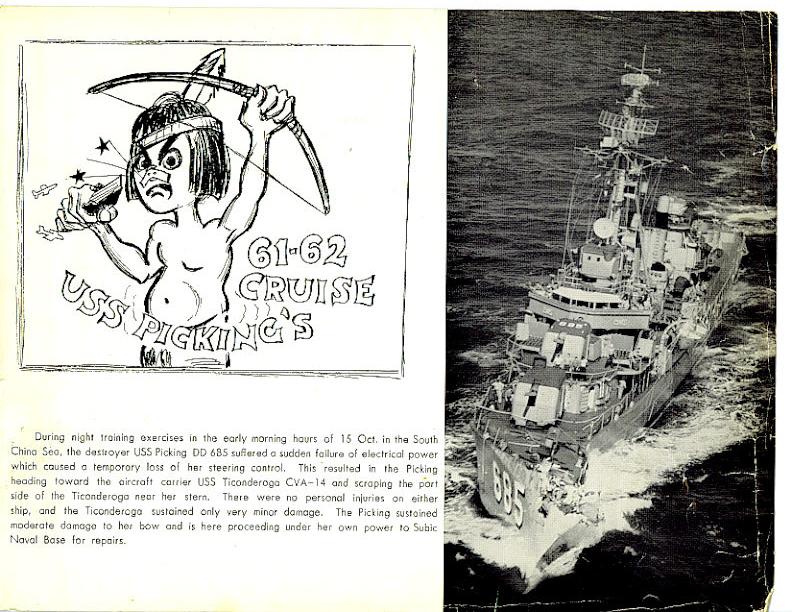
Thanks to Ernie Tafoya
PICKING was used for target practice after decommissioning. She was at Mare
Island, CA. The following pictures and information was provided by Dick Fust.
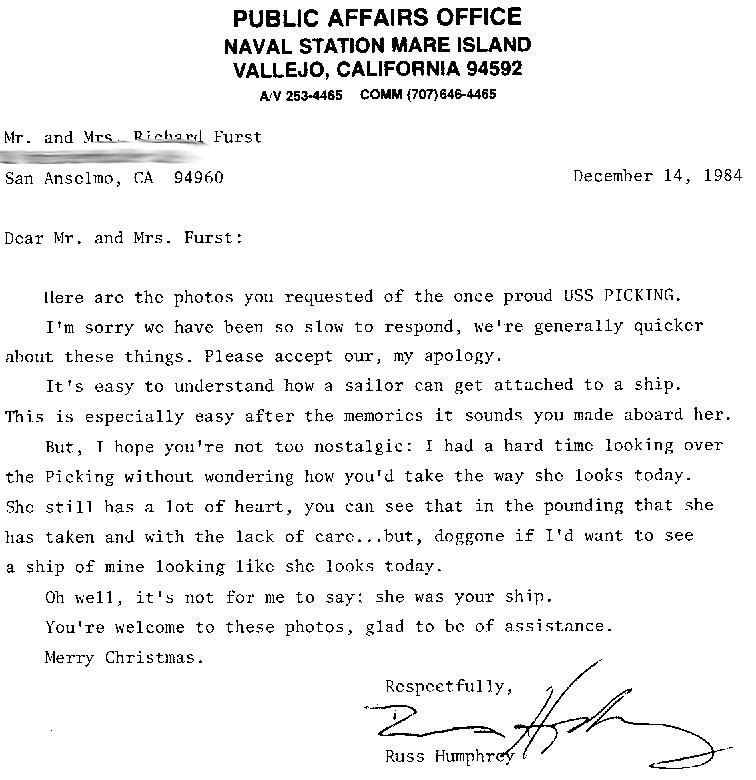
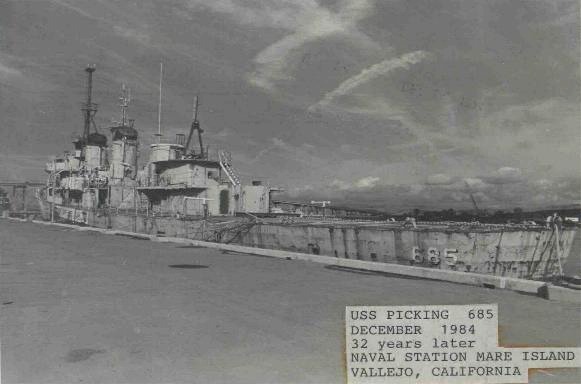
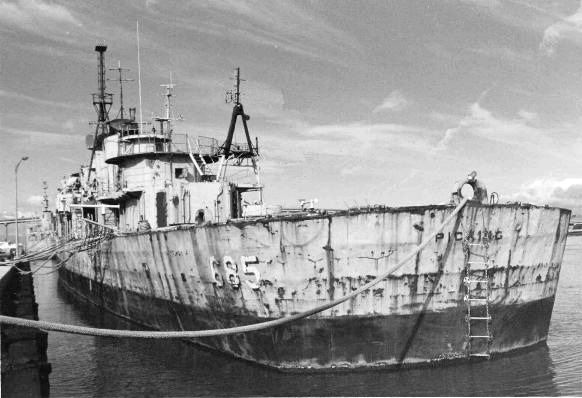
PICKING was sunk as a target off the Southern California coast on 27 February 1997 at 31º 38' 00.4N and 118º 34' 00.7"W. She rests at 1030 fathoms.
